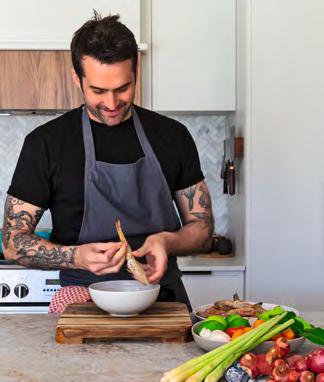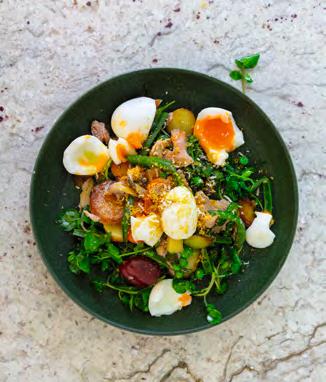








At the time this book went to press, Adam D’Sylva had just moved on after a fourteen-year stint as co-owner and executive chef of Coda, and then Tonka, both in Flinders Lane, Melbourne. Adam continues his run with other projects, currently the gelateria Boca, in Ivanhoe, Melbourne. A chef for more than two-and-a-half decades, his venues capture his mixed heritage. “I’m half Italian and half Indian,” says D’Sylva, who grew up surrounded by food, in particular meat. “My father used to have a butcher’s shop and my mother worked alongside him.” Even before graduating from school, he was working part-time in a pizza store. “I still enjoy making pizzas, particularly for the children,” says D’Sylva, who lives in his house in Thornbury with his wife and their three children.
When the couple purchased the 1960s cream-brick home, it had enough bedrooms, but lacked a great kitchen. “It was more of a galley-style kitchen that was poorly tacked onto the back,” says D’Sylva. There was also a garage at the rear that was too difficult to access, and has been incorporated into a new living wing that now includes the informal living area and an additional bedroom. “We literally doubled the size of this house, including a new dining area, which can accommodate up to twenty-five people with a couple of additional tables,” he adds.
As D’Sylva designed the new kitchen, he was clear on what he wanted and also what he didn’t want. He wanted a long island bench, plenty of storage and a butler’s pantry where he could store many of the kitchen appliances. So unlike other kitchens, where there’s at least a coffee machine or food blender on the benchtop, here one of the few items is a container with a variety of oils, salts and soy sauce. “They’re a permanent fixture, with at least one of these ingredients going into every dish,” says D’Sylva.




Babbington Park in Lyonville, Central Victoria, provides a sanctuary for chef Annie Smithers, who runs du Fermier. Three years ago, she purchased the 9-hectare property with her wife Susan and their two daughters, where they live along with their cats, geese and chooks. Situated at the head of the Loddon River, it draws one’s eye immediately into the landscape, with its rolling hills framed by mature hedges. The couple’s early-twentieth-century cottage is flanked by a series of outhouses, including an 1870s shearing shed, currently being restored, and a delightful church, thought to have been moved onto the property seventy years ago. It’s here where Smithers does most of her cooking, along with her cooking classes, booked out for months ahead.
The church, a short walk from the main house, includes two bedrooms, a bathroom, the open-plan kitchen and living area, together with an annex that’s used for students attending classes to sample the fare, as well as for entertaining friends and family. “I was initially thinking of using this building as a B&B, but it’s perfect for cooking and holding classes.” Simply furnished with a French country-style dining table, it only needed a few minor adjustments from Smithers. There was the addition of the Enzo Catalani pendant light in the living area and in the kitchen, an AGA 60 stove, pivotal to Smithers’ way of cooking with ingredients brought from the farm to the table. With just one large hotplate and two deep ovens below, it provides everything she needs. “I can sauté potatoes, while keeping my soup or sauces warm on the side.” The oven has two speeds, and it’s perfect for the preparation of confit duck. After using AGAs for many years, she knows exactly what heat is required for any dish or even pastries. “Using an AGA is intuitive. It’s like a dancing partner,” says Smithers, who regularly braises certain dishes overnight.



Brigitte Hafner, who owns Graceburn House & Tedesca Osteria in Red Hill on Victoria’s Mornington Peninsula, has several projects going at the one time. As well as establishing an orchard on her Red Hill property, there’s a new restaurant and B&B nearby. With her husband architect Patrick Ness, design director at Cox Architecture, and their daughter Vivienne, how they find time to prepare a great meal at home, let alone get through each day, is extraordinary. However, Hafner is as content being in the kitchen as she is in the garden, which she worked on with her father. “We’ve just planted thirty-six different types of fruit trees, plums, pears, cherries and apples,” says Hafner, who loves retrieving the eggs from the chook house (a miniature Edwardian-style structure) at the top of the embankment. “Just listen to the sound of those chooks,” she says.
The couple purchased the 12-hectare property, a one-and-a-half hour’s drive from Melbourne, five years ago. Originally built in the 1970s, the low-slung mud-brick house had no architectural pedigree. However, the house enjoyed unimpeded views over rolling hills and came with great ‘bones’, including 50-millimetre-thick Oregon floors and chunky messmate tree trunks used as structural columns. “It gets extremely cold down here, with wind and rain lashing the windows on extreme days, and it can be hot in summer,” says Ness, who slowly transformed the house, including a new kitchen, together with modifying some of the previously orange features (orange-stained floor boards and lots of pine joinery). Other changes have been the addition of a separate studio and work sheds.




Daniel Vaughan started to cook as a child. His mother has a passion for cooking and his entire family appreciated her culinary delights, both as children and now, as adults. “The children in our family never bought their school lunches. It was always beautifully prepared in our lunch boxes,” says Vaughan, who operates a number of restaurants and cafés, including The Pantry and The Royale Brothers, in bayside Brighton. He is also a partner at Hugo’s in Manly, Sydney. Although The Pantry was established thirty years ago, there doesn’t seem to be a time when Vaughan hasn’t had a hand in preparing food. Vaughan spent a lot of time on the farms of extended family outside Geelong, and his first paid position as a chef was at the Chevron Hotel on St Kilda Road, Melbourne.

Having a house nearby his string of restaurants and cafés was important for Vaughan and his wife, Narelle, given the hours spent at work. Living in the same suburb would afford him more time to spend with his three teenage daughters and two whippets. The couple’s early 1960s house ticked all the boxes, including being tucked away in a leafy enclave. “It has that feeling of Palm Springs,” says Vaughan, pointing out the split levels, large picture windows and feature stone walls.
While the house was lightly touched when the family moved in, the original kitchen was completely reworked. Originally presenting as a series of small enclosed rooms, with walls dissecting the kitchen and dining area, the appliances were fairly outmoded, with a small wall-mounted oven and rudimentary hotplates below. The benches were also extremely narrow, both for preparing meals and for sitting at. “We rarely use the dining table, even though it’s now been opened up to the kitchen. Nearly all meals are served at the bar, with my wife and three daughters sitting on one side, and me preparing on the other,” says Vaughan.


200 g butter
½ tsp garlic, diced
2 tbsp capers
2 tbsp Kalamata olives, chopped
4 cherry tomatoes, halved
1 lemon, half juiced, half wedges
50 ml oil for frying
1 bunch sage leaves, picked
1 baby snapper
Flour for coating
Salt & pepper, to season
In a small pot, melt butter over a medium heat with garlic and cook out until the white foam begins to turn brown. Quickly add the capers, olives and cherry tomatoes, then remove from the heat and squeeze in the lemon juice to stop the cooking process. Set aside in a warm place.
Fill another small pot with about 1 centimetre of oil and heat over a medium heat. To test if it is the right temperature (180°C) and if you don’t have a thermometer, add a sage leaf. It should bubble vigorously and turn the leaf a darker translucent green. Fry the sage leaves in batches. When ready, remove from oil with a slotted spoon and transfer to a dish lined with paper towel to absorb excess oil.
Toss the baby snapper in the flour and shake off any excess. Heat 50 millilitres olive oil in a large nonstick pan and add baby snapper, season with salt and pepper and reduce to a medium heat and cook for 7 minutes. Gently flip the baby snapper and cook for a further 7 minutes or until cooked through.
Place the baby snapper in the centre of the plate and spoon over the burnt butter sauce generously. Finish with crispy sage leaves and a wedge of lemon.










“… And is it wrong that I want to peer into every pantry, open every fridge, and learn even more about the people behind the big names you are about to meet?”
Matt Preston